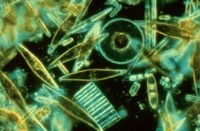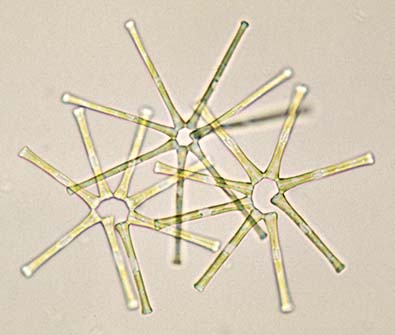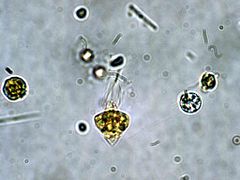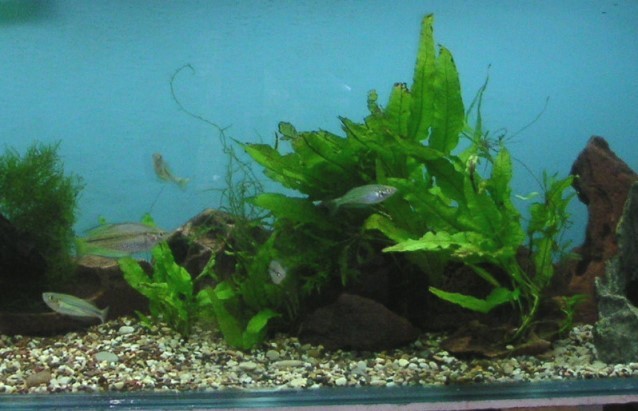|
Algae in freshwater aquaria-
friend or foe?
Algae grows in all aquaria, salt water, brackish or freshwater, and is a sign of life! Perhaps it is better say that algal growth is a fact of life for aquarium keepers and a sign of the water conditions in the aquarium- good and bad. All aquaria will develop algae on sand, gravel, rocks, plants, ornaments, glass walls and the equipment. It is natural and it is possible to control it as part of general maintenance, in most cases. All that is necessary in established, well-cycled tanks is for the viewing sides of the tank to be wiped clean at each water change. I recommend that not all of the algae be removed, and I leave the end walls of the tanks uncleaned of algal growth. I find that when algae is left to grow on the end walls (or on rocks), it helps to consume nitrates and other nutrients and inhibits further growth of unsightly algae on the viewing side of the aquarium. It is also a surface from which some fish will feed, picking at the algae and micro-organisms that grow there. Algae are a necessary food for some fish. For example, algal mats known as Aufwuchs (from German and meaning 'a growth') encrust hard substrates, such as rocks, in both freshwater and marine aquatic environments. Algae, particularly green algae and diatoms, are the main growths and small crustaceans, rotifers, and protozoans form the complex, aufwuchs communities. In freshwater, insect larvae, molluscs, oligochaetes and tardigrades are part of freshwater aufwuchs fauna. Many aquatic animals feed extensively on aufwuchs. The mbuna cichlids from Lake Malawi are particularly well known examples of fish adapted for feeding on aufwuchs. Examples include Labeotropheus trewavasae and Pseudotropheus zebra. They have scraper-like teeth that allow them to rasp the aufwuchs from rocks. [Source] Mollies seek out algal growths and browse on them. In marine communities, aufwuchs is an important source of food for browsing animals such as periwinkles, limpets, chitons and sea urchins. I encouraged the growth of algal mats in my mbuna community tanks, to mimic aufwuchs, and had few blooms of nuisance algae and diatoms. Thus, depending upon the species of fish and the type of biotype that you establish for your aquarium, growing algae may be desirable. Algae is an essential part of the diet of some fishes, such as Mollies, some Rift Valley cichlids, Scats, and species of Otocinclus and Ancistrus. The problem for small to medium sized tanks (those under 200 litre capacity) is that sometimes the biotype and lighting may allow algal growth to become a nuisance. Biological filters also encourage algal growth due to the nitrates produced. Frequent, partial water-changes removes some of the nitrates and reduces plant and algal growth. In a planted aquarium maintained by partial water-changes, the plants and algae compete for the available nitrates (nutrients) and because vascular plants usually dominate in the battle for nutrients, any algal growth is controlled or held in check. Growing aquatic, vascular plants in aquaria controls algal growth. Green algae is found in most well lit aquaria as phytoplankton, algal films, algal mats or hair-like growths. Green algae, including that which appears as green encrustations in freshwater, only grows when the water, lighting and nutrient conditions are at suitable levels for growth required by the plants that we want to flourish in our aquaria as well. In a well planted aquarium, algae does not grow as well, as the vascular plants will usually out pace it in consuming nutrients and block light from algae lower down in the tank. I do not use or advocate the use of plastic or artificial plants for the simple reasons that living plants look better and their presence in an aquarium will limit algae growth most of the time. Algal blooms may occur on occasion, especially when nitrate and phosphate levels increase. Excess green algae can be wiped away or scraped off the glass in the case of "green dot algae". There are exceptions, which are discussed below, under newly established tanks and nuisance algae. Mollies and suckermouth catfish such as Otocinclus sp., or Ancistrus sp., will eat green algae, so I run a few such species in algae susceptible tanks to keep it in control. You need several Otocinclus to do this and the Ancistrus can grow large and eat the plants or wood if algae is not available, however, they are voracious eaters of algae and will clean up a tank in short time. Typically, Otocinclus sp. grow to about 4 or 5 cms and the Ancistrus can grow to 15 cms in length. They require additional feeding of animal and vegetable matter and cannot be expected to live well just on cleaning up algae. Feeding Ancistrus zucchini, lettuce, spinach, cucumbers (all fed raw) tied to a stone with a rubber band ensures a good diet. Brown algae grows when light conditions are too low for most plants. Plants that survive well in low light, such as Java Fern (Microsorum pteropus), Dwarf Anubias (Anubias barteri nana) and Java Moss (Vesicularia dubyana), may be affected by growths of brown algae on their leaves but usually are not affected. A gentle wipe with a cloth may be all that the leaves need to clean away unsightly algae. Keeping suckermouth catfish such as Ancistrus sp. may help keep the algae under check. Increasing the light intensity will allow green algae to grow and replace the brown algae. Single-celled phytoplankton (e.g. algae and euglenids) may be present in aquaria as free swimming, single cells or as colonies in chains. Blooms of euglenids turn the water green or can form simple colonies to encrust surfaces. Read about algae here (an external link). Phytoplankton have been around for a long time and are survivors. Two forms are are notable for aquarists, diatoms and euglenas.
Some growths in aquaria that commonly are called "algae" may in fact be other life-forms such as bacteria, cyanobacteria, slime moulds, fungi and protozoans. Algal blooms may tint the water green (or brownish) and grow excessively in sheets when nitrate levels are above 50 mg / litre (50 ppm). Conditions to decrease the rate of algae growth:
New tanks are notorious for developing algal growths as soon as the nitrogen cycle is producing nitrates (NO3). Nitrates are beneficial nutrients for plants and algae.
Unsightly, brown algae are micro-algae and coat the surfaces with a
brownish growth, as shown in photograph. Brown algae
Yellow-brown "algae" is a mass of diatoms forming a film on the surfaces. It easily wipes away and does not come off in sheets. It can appear as a simple dusting on the tank walls and substrate surfaces, or it can turn into an algal bloom that covers just about everything in the tank. This type of algal outbreak typically occurs when a tank is just completing or has finished the "cycling" process in new tanks. Diatoms are among the first organisms in the tank to benefit from the nitrates produced by a functioning biological filter. If excesses are wiped away or disturbed by using a gravel cleaner (like a vacuum cleaner or bell on the siphon hose) then the build up of other, desirable algae and the growth of plants competes for the nutrients and the diatoms become less of a problem in your tank's ecosystem. Increases in diatom population can be caused by several things, including; too short a daily lighting duration; lights are old and have lost their spectrum; floating plants, algae or calcium build up on the top of your aquarium block light; the water colour (stained by tannins) is too high; suspended particles are absorbing too much light (the filter is not working or the tank is dirty); the lighting intensity is too low. Remember that the deeper light penetrates into water, the more its intensity diminishes. Octocinclus catfish are recommended for control of diatoms and algae but several fish will be needed for the task. Octocinclus are not difficult to acclimatize, in my experience. Green algae grows excessively when both nitrate and light levels are high. It can be wiped from the walls easily using a chemical free cloth or soap-free steel wool (glass is harder than steel and won't scratch unless you trap silicate grit on the cleaning pad). If possible, wipe the algae from surfaces the day before you carry out a water change and change or wash the filter medium. That allows the filter time to remove algae from the water after your house cleaning has added it to the water (not all of the algae stays on the cleaning cloth or steel wool. Remember to always wash the filter medium in the water that you remove from the tank in a water change and NOT in chloraminated tap water. Mollies and some catfish (Ancistrus, Otos, Plecos) may control it but, again, the best control is prevention by good maintenance. Green Dot Algae is a more difficult form to remove. It is usually comprised of encrusting diatoms upon which other green algae have grown and needs to be scraped from the surfaces using a razor blade scraper or steel wool. Fish will not remove it. It is persistent and requires careful scraping to remove. Do not use scapers that will scratch your glass. Green Hair algae or filamentous algae sometimes grow in strong light. Again, an optimum lighting period of 6 hours or reduced lighting and nutrient control will avoid nasty outbreaks. Always wash new plants to remove filamentous algae from the leaves, roots and stems. It can be removed by hand (try twisting it around a toothbrush) and large Mollies will eat hair algae. Red Algae / Black Dot Algae / Black Brush algae can grow in tanks that have high pH and high carbonate hardness such as in tanks with mbuna and other Rift Valley cichlids. Red Algae is the worst algae you will encounter. It appears as blackish dots on aquarium plants, wood, rocks and pebbles or it may grow like bunches of thread known as beard algae, or small clusters or tufts known as black brush algae. This type of algae usually appears in nitrate-rich water with ph over 7.0 and C02 deficient water. It can appear as a black or grey, brush-like growth on rocks, glass, plant leaves and equipment. It is not aufwuchs. In the worst cases of black brush algae that I have seen (in a pet shop), it coated the entire upper surfaces of wood and slow-growing plants such as Anubias, in an unsightly grey-black fuzz. Using bicarbonate to increase alkalinity appears to aid the development of this algae. Using aquarium lights past their half-life when their spectrum is depleted will add to the problem. There are a few Algae eaters that will eat the beard Algae, such as Crossocheilus siamensis (true Siamese flying fox from Thailand) but they will not handle a bad outbreak. Some Plecs (e.g. suckermouth catfish such as Ancistrus sp., Plecostomus sp., Liposarcus sp., Chaestostoma sp., Farlowella sp. Otocinclus sp.,or Hypostomus punctatus) may eat it, as will the Amano shrimp and some other crustaceans as well- but who has those in Australia? The best advice is to keep lighting efficient and to limit the silicates, bicarbonates and phosphates that build up in the tank. Hand remove it, even if that means stripping the plants, or live with it! Black / Blue-green "algae" / cyanobacteria are photosynthesising bacteria that form a loose, slimy, greenish-black coating on the surfaces within the tank. It lifts off easily in thin sheets and easily returns once an outbreak occurs and is difficult to eradicate. Some cyanobacteria also produce a toxin that affects fish (and humans if ingested) and all cyanobacteria should be removed with care. Mild outbreaks may be cured with increased aeration, reduced lighting and reduced nutrient levels. These bacteria are also nitrogen fixing and can grow when nitrates are not present. Treatment with erythromycin (200mg/10 gallons) can eradicate it but the antibiotic will also affect the filter bacteria so the tank will need to be "re-cycled" in all probability after using erythromycin. Wash your hands after contact with cyanobacteria as a precaution against infection. Talking of black things, the black, smelly coating that grows on the bottom of rocks and items buried in the substrate is not an alga but a mass of anaerobic bacteria that develops in low oxygen layers in sand and gravel. It usually indicates poor aeration or over-feeding and the presence of trapped food particles. It is controlled by not over-feeding the fish, increasing oxygenation by improving the aeration and water movement in the tank, not burying the rocks or having sand or gravel beds so deep the the lower layers are without oxygen (anaerobic). Vacuuming the substrate with a bell and siphon gadget will aerate the sand or gravel and remove some of it. Anaerobic bacteria are denitrifying, transforming nitrate into nitrogen gas. The can also produce hydrogen sulphide and other toxic substances- hence the smell. In some marine set-ups, anaerobic bacteria are cultivated in deep beds of coral or aragonite sand over a plenum, to act as effective controls of nitrate. Some anaerobic bacteria produce toxins (e.g., tetanus or botulinum toxins) that are highly dangerous to higher organisms, including humans. The substrate in freshwater tanks is usually too shallow for anaerobic bacteria to develop. Plant roots won't grow in that layer so it is best to avoid letting it happen. So don't over feed; don't bury rocks too deeply and aerate the tank and allow the substrate to be oxygenated by not being too deep. ALGICIDES can be used in extreme cases to eradicate algae but care must be used in using these chemicals. They come in tablet, blocks and liquids. Consult your stockist and DO read the labels and use the products carefully. Algae on plastic plants and equipment can be removed by using strong bleach. Take the items out of the aquarium and scrub them in chlorine bleach to remove all algae. Rinse the plastic plants or items in fresh water to remove all traces of chlorine and wash them in water treated with dechlorinating solutions before returning them to the aquarium. Keep ALL chlorine bleach away from your fish. If you are using plastic plants because of low light, try using Java Fern (Microsorum pteropus), Dwarf Anubias (Anubias barteri nana) and Java Moss (Vesicularia dubyana) as living alternatives to plastic that thrive in low light. A Link to more detailed information on algae control. A List of Algae Eaters (fishes) People eat algae too- in Spirulina products and jellies made from agar. |
||||||
|
GOOD LUCK WITH YOUR RAINBOWS
|
 Marine
diatoms
Marine
diatoms Asterionella, a colony
of pennate diatoms photographed by
Asterionella, a colony
of pennate diatoms photographed by
 Euglenas 240px
Euglenas 240px
 grow in low light
when nutrients are available and usually die back when green algae or aquatic
plants grow well under adequate lighting. It is easily wiped away with a
cleaning cloth. Increasing the light intensity (not just the duration) will
alleviate the problem with brown algae as it does not compete well with plants
and green algae.
grow in low light
when nutrients are available and usually die back when green algae or aquatic
plants grow well under adequate lighting. It is easily wiped away with a
cleaning cloth. Increasing the light intensity (not just the duration) will
alleviate the problem with brown algae as it does not compete well with plants
and green algae.